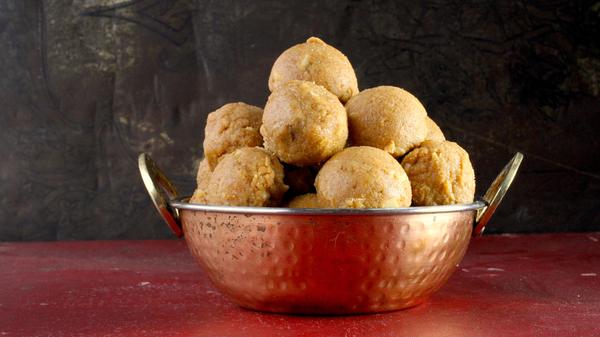The casual Indian food consumer might be familiar with gulab jamun or jalebi, but the average Indian sweet shop case requires pro-level sweets knowledge (or a serious sweet tooth). All mithai—a Hindi/Urdu word for sweets—are made with some combination of flour, sugar, nuts, legumes, and milk or khoya (a semi-solid dairy product made by slowly boiling milk until it thickens), and then often enhanced with cardamom, rose water, or saffron. Most are either dry or semi-hard, and soaked in either milk or sugar syrup. While there are a few classic forms, regional variations and nods to local preference abound. Here's a starter guide to South Asia's treasured desserts.
Advertisement
Top row: tricolor barfi, kesar peda (x3), malai cham cham; Middle row: chocolate barfi, kesar peda, kalakand, boondi ladoo; bottom row: pista barfi, malai cham cham, boondi ladoo, malai cham cham. Photo courtesy of the author.
Barfi are square or diamond sugar-and-khoya treats with a fudge-like consistency, often glazed with vark, or edible silver leaf. They're popular in Northern India and distributed on special occasions like weddings or Diwali. While they're most often white, they also come in a broad range of flavors, like pistachio, almond, chocolate, mango, or pineapple-orange. There are also regional variations, like Gujarati mohanthal, made with gram (chickpea) flour instead of milk solids; Rajasthani kalakand, made with whole milk, which gives it a silky texture and a deep milky flavor; and patisa or soan papdi, a drier, flakier square-shaped sweet also made with gram flour.
A stack of barfi. Photo courtesy of the author.
Halwa are made by simmering something (usually fruit, grated vegetables, or flour), with milk, sugar, and ghee. They're usually more gelatinous than barfi, and the vegetable ones (like carrot and calabash) tend to be the most popular in the U.S., though fruitier flavors like sapodilla and date aren't unusual either. You'll mostly see them garnished with nuts.
Peda. Photo by Farideh Sadeghin.
Peda are round, semi-soft, grainy condensed milk or milk powder desserts. They are often associated with the holy cities of Varanasi and Mathura, their places of origin in north India—which is why they are commonly distributed in temples as prasad, or a religious offering of food. The most commonly available favors of peda are saffron and pistachio.
MAKE THIS: Pistachio Peda
Advertisement

Like peda, ladoo are also common prasad in Hindu temples. These round, sweet balls can be made from a variety of grains and seeds; the most common ladoo found in U.S. shops are nutty besan ladoo (made of gram flour, sugar, ghee, and cardamom powder) and crumbly motichoor ladoo (tiny, deep-fried gram flour "pearls" simmered in sugar and shaped into balls). Other regional varieties include Rajasthani atta ladoo, made with whole wheat flour, and Maharashtrian til ladoo, made with sesame seeds.
Sweets from the eastern state of West Bengal are made with chhana, a fresh curd cheese originally of Portuguese origin. Sandesh are small sweet meats, fried in ghee and often molded into pretty shapes; Bengali rosogolla are spongy balls of chhana simmered in and then served in sugar syrup. Oblong cham cham are cooked in a similar manner to rosogolla, but incorporate both chhana and khoya and come in a variety of flavors and colors, like malai (white) and rose water (pink).MAKE THIS: Besan Ladoo
Jalebi. Photo by the author.
Jalebi are deep-fried, spiral, funnel-cake like confections made from either wheat or lentil flour. Once fried, they're soaked in a warm sugar syrup that's usually flavored with cardamom and saffron. They're crispy on the outside and chewy on the inside, and ooze sticky syrup with every bite. The dish traces its roots to west Asia, and likely made its way to the subcontinent in the 14th or 15th century via trade.Gulab jamun, too, was introduced to South Asia by west Asians. These dense, golden brown balls of khoya, dunked in sugar syrup spiked with cardamom, rose water, and saffron, is most likely traceable to a Persian fritter. In kala jamun, literally "black jamun," a popular variant, sugar is added to the khoya batter; when the fritters are deep-fried, the sugar caramelizes, giving the dessert its dark, almost black, color.Of course, depending where you are, there are countless regional variations on each of these. Your best bet? Get one of everything.
